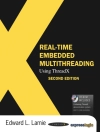Learn how to provide seamless, high quality multimedia for the
wireless Internet
This book introduces the promising protocols for multimedia
services and presents the analytical frameworks for measuring their
performance in wireless networks. Furthermore, the book shows how
to fine-tune the parameters for Quality of Service (Qo S)
provisioning in order to illustrate the effect that Qo S has upon
the stability, integrity and growth of next generation wireless
Internet. In addition, the authors provide the tools required to
implement this understanding. These tools are particularly useful
for design and engineering network architecture and protocols for
future wireless Internet. Additionally, the book provides a good
overview of wireless networks, while also appealing to network
researchers and engineers.
Key Features:
* Provides a comprehensive and analytical understanding of the
performance of multimedia services in wireless Internet, and the
tools to implement such an understanding
* Addresses issues such as IEEE 802.11, AIMD/RED (Additive
Increase-Multiplicative Decrease/ Random Early Detection),
multimedia traffic models, congestion control and random access
networks
* Investigates the impact of wireless characteristics on Qo S
constraint multimedia applications
* Includes a case study on AIMD for multimedia playback
applications
* Features numerous examples, suggested reading and review
questions for each chapter
This book is an invaluable resource for postgraduate students
undertaking courses in wireless networks and multimedia services,
students studying advanced graduate courses in electrical
engineering and computer science, and researchers and engineers in
the field of wireless networks.
表中的内容
About the Series Editors.
About the Authors.
Preface.
1 Introduction.
1.1 Convergence of Wireless Systems and the Internet.
1.2 Main Challenges in Supporting Multimedia Services.
1.3 Organization of the Text.
2 Packet-level Wireless Channel Model.
2.1 Introduction.
2.2 Finite-state Markov Model for Fast Fading Channels.
2.3 Channel Model for Frequency-selective Fading Wireless
Channels.
2.4 Channel Model for Indoor UWB Wireless Channels with
Shadowing.
2.5 Summary.
2.6 Problems.
3 Multimedia Traffic Model.
3.1 Modeling Vo IP Traffic.
3.2 Modeling Video Traffic.
3.3 Performance Study of Video over Wired and Wireless
Links.
3.4 Scalable Source Coding.
3.5 Summary.
3.6 Problems.
4 AIMD Congestion Control.
4.1 Introduction.
4.2 AIMD Protocol Overview.
4.3 TCP-friendly AIMD Parameters.
4.4 Properties of AIMD.
4.5 Case Study: Multimedia Playback Applications with Service
Differentiation.
4.6 Performance Evaluation.
4.7 Summary.
4.8 Problems.
5 Stability Property and Performance Bounds of the
Internet.
5.1 A Fluid-flow Model of the AIMD/RED System.
5.2 Stability and Fairness Analysis with Delay-free Marking.
5.3 Boundedness of the Homogeneous-flow AIMD/RED System with
Time Delay.
5.4 Summary.
5.5 Problems.
6 AIMD in Wireless Internet.
6.1 Introduction.
6.2 Related Work.
6.3 System Model.
6.4 Analytical Model for Window-controlled Flows.
6.5 Parameter Selection for AIMD.
6.6 Performance Evaluation.
6.7 Summary.
6.8 Problems.
7 TCP-friendly Rate Control in Wireless Internet.
7.1 Introduction.
7.2 System Model.
7.3 Analytical Model for Rate-controlled Flows.
7.4 Performance Evaluation.
7.5 Summary.
7.6 Problems.
8 Multimedia Services in Wireless Random Access
Networks.
8.1 Brief History of Random Access Technologies.
8.2 IEEE 802.11 Protocol.
8.3 WLAN with Saturated Stations.
8.4 WLAN with Unbalanced Traffic.
8.5 TFRC in the Mobile Hotspot.
8.6 Summary.
8.7 Problems.
Appendices.
Appendix A TCP and AQM Overview.
A.1 TCP Protocol.
A.1.1 TCP connection management.
A.1.2 TCP error control.
A.1.3 TCP flow control and congestion control.
A.2 Active Queue Management.
Appendix B Datagram Congestion Control Protocol
Overview.
B.1 DCCP-2: TCP-like Congestion Control.
B.2 DCCP-3: TFRC Congestion Control.
References.
Index.












